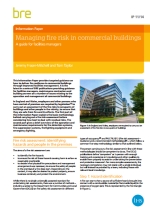Managing fire risk in commercial buildings: A guide for facilities managers
BRE (Building Research Establishment) is an independent, research-based consultancy, testing and training organisation, operating in the built environment and associated industries.
Managing fire risk in commercial buildings: A guide for facilities managers (IP 11/14) was published by BRE on 23 September 2014. It was written by Jeremy Fraser-Mitchell and Tom Taylor. It is one of a number of BRE publications offering guidance for facilities managers, maintenance contractors and building owners about the operation and management of commercial buildings.
In England and Wales, employers and other people who have control of premises must carry out an assessment of the fire risks to occupants of buildings and other people in the vicinity, to ensure that they are safe from fire and its effects. IP 11/14 provides guidance about how improved facilities management can help deliver fire resilience in commercial buildings.
The first part of the 8-page Information Paper explains how to carry out a fire risk assessment and how best to deal with residual risks. The second part gives an overview of operational and maintenance requirements for fire detection systems, fire suppression systems, firefighting equipment and emergency lighting.
The contents of the Information Paper are:
- Fire risk assessment: identifying hazards and people in the premises.
- Fire risk management: coping with residual risks.
- Planning, recording, instruction and training.
- Fire protection equipment and facilities.
- Conclusions.
- References.
[edit] Related articles on Designing Buildings Wik
- Automatic fire detection and alarm systems, an introductory guide to components and systems BR 510.
- Automatic fire sprinkler systems: A good practice guide.
- BRE articles on Designing Buildings Wiki.
- BRE Buzz articles on Designing Buildings Wiki.
- BRE Buzz.
- Building Research Establishment.
- External fire spread, Supplementary guidance to BR 187 incorporating probabilistic and time-based approaches.
- External fire spread: building separation and boundary distances (BR 187).
- Fire performance of external thermal insulation for walls of multistorey buildings, third edition (BR 135).
- Fire risk in high-rise and super high-rise buildings DG 533.
- Fire safety certification from CIOB.
- Fire suppression.
- Managing risks in existing buildings: An overview of UK risk-based legislation for commercial and industrial premises (FB 86).
- Risk assessment under The Regulatory Reform (Fire Safety) Order 2005.
- The Regulatory Reform (Fire Safety) Order 2005.
- The role of codes, standards and approvals in delivering fire safety.
- Understanding the factors affecting flashover of a fire in modern buildings.
- Visual alarm devices - their effectiveness in warning of fire.
Featured articles and news
A change to adoptive architecture
Effects of global weather warming on architectural detailing, material choice and human interaction.
How big is the problem and what can we do to mitigate the effects?
Overheating guidance and tools for building designers
A number of cool guides to help with the heat.
The UK's Modern Industrial Strategy: A 10 year plan
Previous consultation criticism, current key elements and general support with some persisting reservations.
Building Safety Regulator reforms
New roles, new staff and a new fast track service pave the way for a single construction regulator.
Architectural Technologist CPDs and Communications
CIAT CPD… and how you can do it!
Cooling centres and cool spaces
Managing extreme heat in cities by directing the public to places for heat stress relief and water sources.
Winter gardens: A brief history and warm variations
Extending the season with glass in different forms and terms.
Restoring Great Yarmouth's Winter Gardens
Transforming one of the least sustainable constructions imaginable.
Construction Skills Mission Board launch sector drive
Newly formed government and industry collaboration set strategy for recruiting an additional 100,000 construction workers a year.
New Architects Code comes into effect in September 2025
ARB Architects Code of Conduct and Practice available with ongoing consultation regarding guidance.
Welsh Skills Body (Medr) launches ambitious plan
The new skills body brings together funding and regulation of tertiary education and research for the devolved nation.
Paul Gandy FCIOB announced as next CIOB President
Former Tilbury Douglas CEO takes helm.
UK Infrastructure: A 10 Year Strategy. In brief with reactions
With the National Infrastructure and Service Transformation Authority (NISTA).
Ebenezer Howard: inventor of the garden city. Book review.
Airtightness Topic Guide BSRIA TG 27/2025
Explaining the basics of airtightness, what it is, why it's important, when it's required and how it's carried out.























